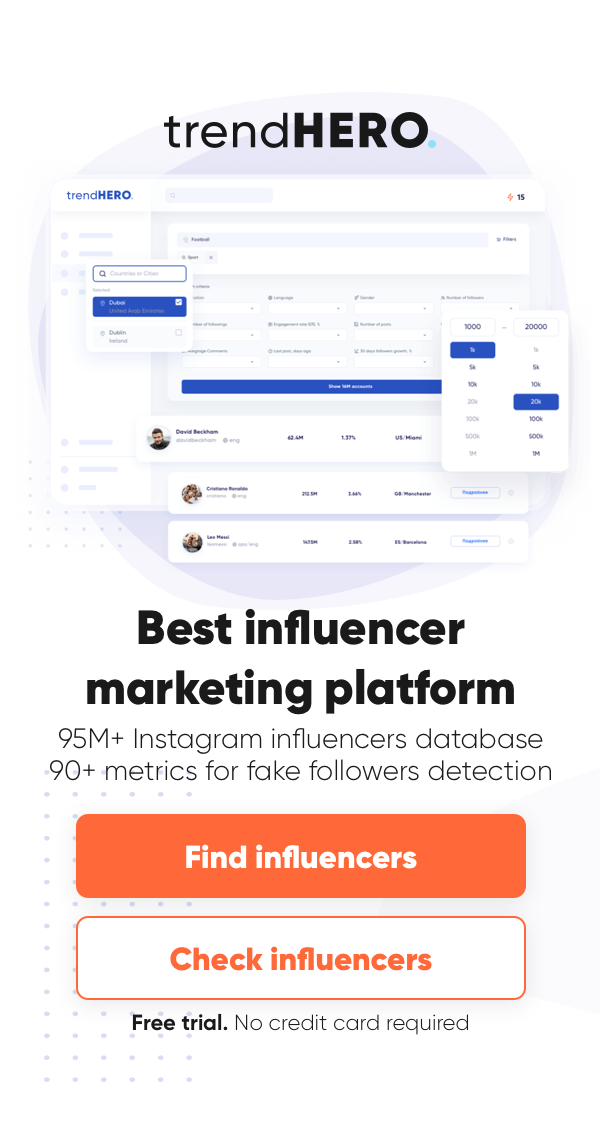- Home
- BLOG
- Instagram Business
- How to Measure Influencer Marketing and Set KPIs?
Have you ever marketed a brand using word-of-mouth? If yes, then you’re not new to influencer marketing – it has been used since the late 1800s. But thanks to technology, it has become a big part of digital marketing.
There’s a growing number of influencers on various social network platforms; Instagram alone has reached two billion active users worldwide according to Bloomberg. However, influencers have been increasing throughout the years, including Instagram influencers.
With the overwhelming number, entrepreneurs shouldn’t take digital marketing for granted. Using these influencers will have a significant contribution to their business growth. This means it’s important to measure the success of an influencer marketing campaign.
In this article, I’ll cover the KPIs to measure influencer marketing and provide you with relevant tracking tools to ensure its efficiency and success.
The Benefits of Influencer Marketing for Your Business Growth
Influencer marketing has been growing all these years. More and more small businesses have been using this strategy because of its benefits:
- Improves brand awareness. Influencer marketing can expand your reach and give you a better position in the market. Many people will know more about your company, story, and the products and services you offer.
- Provides vast visibility and reach. Utilizing digital ads is great; however, more and more consumers are using ad blockers on their browsers. With influencer marketing, you’d be able to reach your target market more efficiently.
- Builds trust and shows authority regarding the brand. When you collaborate with an influencer, their followers will most likely trust them. Since they are endorsing your products, leads could go up
- Generates leads and drives conversions. As mentioned above, influencers can generate more leads. They could also help with conversions and give you higher sales.
Influencers can drive leads, and help your business convert them as their followers trust what they recommend. When you collaborate with an influencer, you can expect that sales will go up, especially when you and the influencer share the same vision.
However, you need to measure the necessary KPIs to ensure its success. Keeping track of conversions, referral traffic, reach and awareness, audience growth, and engagement are critical KPIs to track.
Setting the Measurable KPIs for Influencer Marketing
There are tons of KPIs out there, and each of them has its purpose. Some of them could be ideal for other marketing strategies, while others are specific. So what metrics should you measure? First of all, identify your goals. Here are some suggestions:
Identify Goals for Influencer Marketing
Goals are essential for every marketing campaign. SMART goals you can consider for influencer marketing include:
- Specific: Increase brand awareness by X% among the target audience.
- Measurable: Track engagement rates and brand mentions on social media.
- Achievable: Partner with influencers who have a relevant and engaged audience.
- Relevant: Align influencer campaigns with overall marketing goals and strategies.
- Time-bound: Set a specific timeframe for the campaign and measure progress towards goals at regular intervals.
After identification of goals you need to
Audience Reach
This metric is ideal when your main goal is to increase brand awareness. To maximize the views, it’s best to get influencers with thousands of followers. If they have a lot, it’d be easier for the business to market the brand as it’d increase its visibility.
Imagine working with an influencer; as they introduce your brand to their followers, you’re getting a new audience. This means more and more people will become aware that your brand exists.
A certain number of audiences will try your products, sign up for your newsletter, follow your social media accounts, and have other forms of engagement. These engagement actions make the influencer marketing campaign a valuable asset in your organization.
Trackable Assets
As an entrepreneur, believe me, measuring ROI across campaigns on social media isn’t simple. The good thing about it is that the entire system can be tracked. For instance, you can utilize coupon codes and custom URLs to check how users interact with them anytime.
One of the most common strategies companies do is personalizing coupon codes. They turn the influencer’s name into a discount coupon. For instance, they can offer a 10% discount when users key in the name of the person.
Creators increase their engagement rates while the companies have a boost in sales, making it a win-win situation for both parties. Marketers can also keep track of how many coupons were activated and measure the impact.
Engagement Rate
The engagement rate is a marker that you can utilize to check the impact a post makes. For instance, they created an Instagram post. How do you measure its engagement? Here’s the order of importance.
- Clicks. If the followers understand and love the content, they would follow the CTA, and most likely visit the company’s website to get the details they want or know more about the organization. You’ll have to measure the number of clicks, which is quite difficult to track. However, you can use some tools to track all the clicks.
- Shares. When users share the influencers’ posts, this means it’s valuable. It suggests that the content is good enough to tell their friends about it.
- Comments. Users give a few seconds to comment on the post. This signals that they are interested in the topic. Unfortunately, most posts nowadays don’t give much value to influencers and brands as they just comment with “hi” and “hello”.
- Likes. I would say that this is the weakest because hitting the like button is the easiest. Users don’t even need to read what the post is about. However, it is still considered as potential.
Sales
Since this is marketing, identifying how persuasive the sponsored posts are is vital. The influencer creates quality content, and the followers will see the value of the products promoted. This means the influencer has a huge role when it comes to convincing consumers to purchase the products.
You’ll be able to see if the partnership is effective when the brand gets sales or subscriptions during the marketing campaign. This will show whether you’re getting revenue from the partnership.
Tracking this influencer marketing KPI is quite simple. Marketers have to monitor the number of sales per day during the campaign period. The higher the sales are means your partnership is more effective.
Social Sentiment
When it comes to engagement, you’ll need to identify how the users react to the marketing campaign. For instance, if the post is getting positive feedback from users, that’ll make it easier for the content to get more positive attention from more people.
For me, this is one of the main influencer marketing KPIs that need critical attention. The nature of social networks is to look for a connection. This means it’s more focused on emotion rather than reason.
Many organizations have recognized the importance of social sentiment. Comments are the easiest way to learn how the public feels. If you read through the comments, you’ll see people expressing their opinions and emotions.
Return on Investment
You’d be able to use influencer marketing KPIs to monitor investments and revenue, and see whether the outcome of your social media campaign creates ROI. The process is straightforward; make sure that you check the necessary stages below:
Create a budget. When you set your budget, you have to research the influencer market. Make sure that you set a realistic and optimal investment to get the results you want.
Negotiate the price for each influencer. Contact each creator on your list (especially the ones relevant to your product or brand), and agree together regarding the price. This will help you determine how much the overall expenses for the campaign.
Establish your goals. Make sure that your goals are clear. This will help you focus more on reaching your goals, and aligning your ROI measurements with goal tracking.
Track sales registered while the campaign is ongoing. Determine the sales your influencers generated during the project. Of course, you need to check whether the project tops your allocated budget.
Calculating the ROI of Influencer Marketing
Calculating the return on investment (ROI) of influencer marketing can be done by using the following formula:
ROI = (Revenue generated from influencer campaign – Costs of influencer campaign) / Costs of the influencer campaign
To calculate the ROI, you will need to track certain metrics mentioned above.
Once you have gathered this data, you can use it to calculate the ROI and evaluate the effectiveness of the campaign. Keep in mind that influencer marketing ROI is not only about direct revenue, but also about brand awareness, engagement and credibility.
KPI Tracking tools
Influencer marketing has been deemed a powerful digital marketing campaign. Since digitization is the presence of work, more and more businesses go digital with their business processes, especially with their marketing.
By utilizing technology, you can monitor the important metrics for your marketing efforts. To effectively track these KPIs, data analytics plays a crucial role. With the evolution of technology, AutoML is boosting business analytics.
The best part is that there are tons of them. Here are some KPI tracking tools to help you monitor your marketing KPIs.
Google Analytics
When it comes to monitoring analytics, Google Analytics is the top one! The basic version comes without a price, yet still provides a clear view of the necessary metrics on a single dashboard.
You’ll also be able to generate reports, making monitoring your marketing KPI more straightforward.
Instagram Insights
Since there are billions of users on Instagram, you must use this tool. It gives you a detailed breakdown of your posts. The downside of this tool is that it’s only available on the mobile version and only the creator can have access to it.
It also has a disclaimer where it states that some metrics are still in development. However, I think that you should be using this tool, especially if you’re collaborating with an influencer.
Youtube Analytics
If you’re publishing videos on Youtube, then you need Youtube Analytics to stay on top of your content. The platform gives you details on major video marketing KPIs. This includes audience demographics, watch time, traffic sources, and other forms of engagement.
The tool features real-time data and analytics, providing you with more visibility regarding the metrics you need to measure.
Facebook Page Insights
Similar to Instagram Insights, Facebook has its own platform where you can see your business’s page status. You’ll be able to set your marketing KPIs to optimize the results.
The tool allows you to see how many see your posts, and which ones are engaging. This gives you better visibility and control as you’ll see how each post performs, what you’re doing on the page and a lot more.
Examples of Successful Influencer Marketing Campaigns
One example of a successful influencer marketing campaign is from Pepsi. They aimed to boost their sales at Walgreens. Aside from creating limited edition packaging for their product, they used the hashtag #SayItWithPepsi. Their targets were the millennials, making social media engagement their priority.
The goal was to establish more fun summer activities with Pepsi’s limited edition packaging, which is only available at Walgreens. They used influential creators to boost the marketing campaign, resulting in 26,000 clicks on the content shared, and reaching more than 50,000 engagements during the campaign period.
Another example was the PlayStations VR headset campaign in Canada, aiming to provide an outstanding gaming experience with Sony. The influencers shared their content while having fun playing games using the PlayStation VR.
They used the hashtags #PSVR, #ITriedPSVR, and #PlayStationVR then tagged PlayStation Canada’s official page. The campaign gained a 3.64% engagement rate on multiple platforms.
Tips for Continuous Tracking and Reporting of Influencer Marketing Results
Influencer marketing is a continuous trend, and should never be underestimated. Regular monitoring is vital, and when monitoring influencer marketing performance, you should always check whether it meets the KPIs set.
Analyze the data and create necessary adjustments to succeed in the campaign. If you see that there’s not much movement on the KPIs set, and your goal seems far to reach, change the direction right away. Always evaluate reach, relevance, activity, and performance engagement.
For instance, if the goal is to increase brand awareness, check whether you are using relevant hashtags and whether you are collaborating with an influencer that gives a huge impact on your target audience – evaluate the relevance, performance engagement, and activity.
When monitoring and reporting, always use the right tools to ensure the accuracy of the data. The data itself will help you understand whether you need to change something in your campaign or the direction that will lead you to the campaign’s goal.
Sum up on influencer marketing measurement
We are now living in a digital world. I’ve seen people who are always on their devices, checking various posts on social media from the influencers they follow. This is a perfect opportunity to market your brand to the public.
The good thing about technology is that marketers and influencers can work together and accomplish amazing things. However, the critical part of this is the monitoring of the metrics.
The ones mentioned above are what I suggest you measure when it comes to influencer marketing. Don’t forget to use KPI tools to make the job more straightforward, and have better visibility regarding the metrics.
Instagram Engagement Rate Calculator For Free
Check any influencer's Engagement rate and analyze his or her followers growth history
Other free tools: Follower Count History, Instagram Follower Count, CPM Calculator





